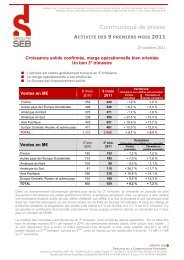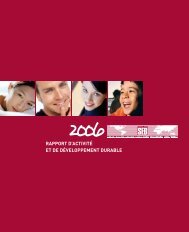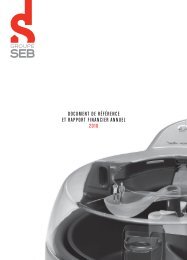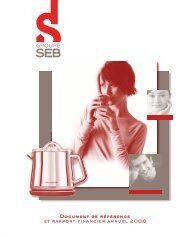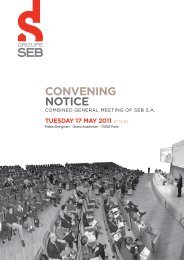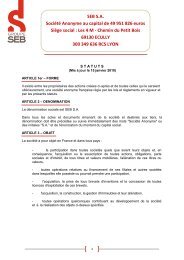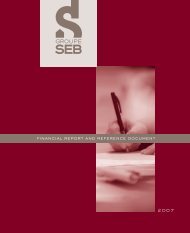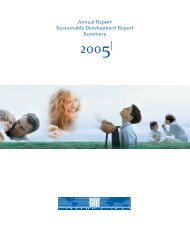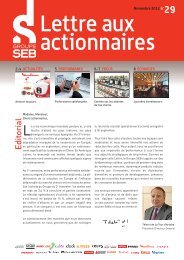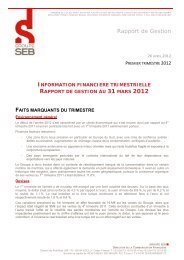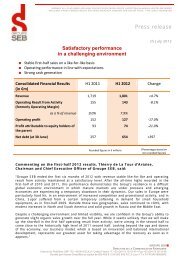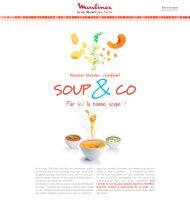financial report and registration document 2011 - Groupe SEB
financial report and registration document 2011 - Groupe SEB
financial report and registration document 2011 - Groupe SEB
You also want an ePaper? Increase the reach of your titles
YUMPU automatically turns print PDFs into web optimized ePapers that Google loves.
5 Notes<br />
Consolidated fi nancial statements<br />
to the consolidated fi nancial statements<br />
Maintenance <strong>and</strong> repair costs are expensed as incurred.<br />
The main useful lives are as follows:<br />
� buildings: 10 to 40 years;<br />
� plant <strong>and</strong> machinery: 10 years;<br />
� offi ce equipment: 3 to 10 years;<br />
� vehicles: 4 to 5 years;<br />
� tooling: 1 to 5 years.<br />
Each signifi cant part of an item of property, plant <strong>and</strong> equipment with a useful<br />
life that is different from that of the asset to which it belongs is depreciated<br />
separately. Useful lives are reviewed at regularly intervals <strong>and</strong> the effect of<br />
any adjustments – corresponding to a change in accounting estimates – is<br />
applied prospectively.<br />
No items of property, plant or equipment have been revalued.<br />
In accordance with IAS 17 – Leases, fi nance leases that transfer substantially<br />
all the risks <strong>and</strong> rewards incidental to ownership of an asset to the lessee are<br />
recognised in property, plant <strong>and</strong> equipment for an amount corresponding<br />
to the lower of the fair value of the leased asset <strong>and</strong> the present value of the<br />
minimum lease payments. A liability for the same amount is recorded under<br />
“Finance lease liabilities”.<br />
1.4.3. Impairment of non-current assets<br />
In accordance with IAS 36 – Impairment of Assets, the Group assesses<br />
at the end of each <strong>report</strong>ing period whether there is any indication that its<br />
property, plant <strong>and</strong> equipment <strong>and</strong> intangible assets may be impaired. If any<br />
such indication exists, the assets are tested for impairment. Assets with an<br />
indefi nite useful life – corresponding in the case of <strong>Groupe</strong> <strong>SEB</strong> to goodwill<br />
<strong>and</strong> trademarks – are tested for impairment at least once a year, irrespective<br />
of whether there is any indication of impairment.<br />
Assets with a fi nite useful life are tested whenever events or circumstances<br />
indicate that their carrying amount may not be recovered.<br />
Impairment tests are performed at the level of each Cash-Generating Unit<br />
(CGU). A CGU is defi ned as the smallest identifi able group of assets that<br />
generates cash infl ows that are largely independent of the cash infl ows<br />
from other assets or groups of assets. An impairment loss is recognised<br />
for any excess of an asset’s carrying amount over its recoverable amount.<br />
Recoverable amount corresponds to the higher of the asset’s fair value less<br />
costs to sell <strong>and</strong> its value in use, calculated using the discounted cash fl ows<br />
method. The impairment loss is allocated to reduce the carrying amount of<br />
goodwill <strong>and</strong> then prorata to the other assets of the CGU based on their<br />
respective carrying amounts.<br />
The capitalised amount of development projects in progress is also tested<br />
for impairment.<br />
Impairment losses on CGUs <strong>and</strong> on assets with an indefi nite useful life are<br />
recorded in “Other operating income <strong>and</strong> expense”.<br />
At <strong>Groupe</strong> <strong>SEB</strong>, CGUs correspond to individual production sites, broken<br />
down where appropriate by product family. The assets allocated to<br />
each CGU correspond mainly to tooling <strong>and</strong> other manufacturing assets<br />
(primarily buildings <strong>and</strong> machinery). Marketing subsidiaries <strong>and</strong> integrated<br />
manufacturing <strong>and</strong> sales entities are each treated as separate CGUs, but<br />
marketing subsidiaries that share resources are combined in a single CGU.<br />
Impairment losses recognised for non-fi nancial assets other than goodwill are<br />
reviewed at each annual <strong>and</strong> interim period-end <strong>and</strong> adjusted as necessary.<br />
1.4.4. Financial instruments<br />
Financial instruments are accounted for in accordance with IAS 39 – Financial<br />
Instruments: Recognition <strong>and</strong> Measurement.<br />
Financial assets <strong>and</strong> liabilities are recognised in the balance sheet when<br />
the Group becomes a party to the contractual provisions of the instrument.<br />
They are initially recognised at cost, corresponding to the fair value of the<br />
consideration paid or received plus external transaction costs that are<br />
directly attributable to the acquisition or issue of the fi nancial asset or<br />
fi nancial liability.<br />
A) FINANCIAL ASSETS<br />
Financial assets consist of shares in subsidiaries <strong>and</strong> affi liates, as well as<br />
operating receivables, debt securities <strong>and</strong> other cash equivalents classifi ed<br />
as current assets.<br />
Available-for-sale fi nancial assets are assets that are intended to be held<br />
for an indefi nite period but which may be sold in response to changes in<br />
market interest rates or liquidity needs. They comprise investments in nonconsolidated<br />
companies.<br />
At each period-end, they are measured at fair value <strong>and</strong> the resulting<br />
unrealised gains or losses are recognised directly in equity. When the assets<br />
are sold or there is objective evidence of impairment, the cumulative gains<br />
<strong>and</strong> losses previously recognised in equity are reclassifi ed to profi t.<br />
Held-to-maturity investments are fi nancial assets with a fi xed maturity that<br />
the Group has the positive intention <strong>and</strong> ability to hold to maturity. They are<br />
measured at amortised cost, determined by the effective interest method.<br />
B) FINANCIAL LIABILITIES<br />
Financial liabilities comprise borrowings <strong>and</strong> other fi nancing, including bank<br />
overdrafts <strong>and</strong> operating liabilities.<br />
Borrowings <strong>and</strong> other fi nancial liabilities are measured at amortised cost,<br />
determined by the effective interest method.<br />
When interest rate risks on fi nancial liabilities are hedged by swaps qualifying<br />
as cash fl ow hedges, the swaps are also recognised in the balance sheet at<br />
fair value. The effective portion of changes in their fair value is recognised<br />
directly in equity <strong>and</strong> the ineffective portion is recognised in profi t.<br />
C) DERIVATIVE INSTRUMENTS<br />
Market risks (interest rate, currency <strong>and</strong> commodity price risks) are hedged,<br />
generally through the use of derivative instruments.<br />
In accordance with IAS 32 <strong>and</strong> IAS 39, derivative instruments are measured<br />
at fair value.<br />
The accounting treatment of changes in fair value depends on the future use<br />
of the derivative <strong>and</strong> the resulting accounting classifi cation.<br />
86 GROUPE <strong>SEB</strong> Financial Report <strong>and</strong> Registration Document <strong>2011</strong>



